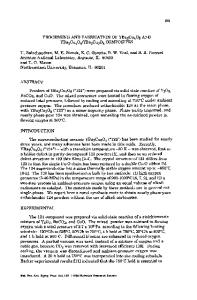Anisotropy of the Complex Permittivity of the Kagome-Staircase Compounds Co 3 V 2 O 8 and Ni 3 V 2 O 8 : Experiment and
- PDF / 809,511 Bytes
- 5 Pages / 612 x 792 pts (letter) Page_size
- 42 Downloads / 283 Views
DISORDER, AND PHASE TRANSITION IN CONDENSED SYSTEM
Anisotropy of the Complex Permittivity of the Kagome-Staircase Compounds Co3V2O8 and Ni3V2O8: Experiment and Ab Initio Calculations A. A. Makhneva,*, A. V. Lukoyanova,b, L. V. Nomerovannayaa, A. A. Shirokovb, S. N. Bariloc, G. L. Bychkovc, and S. V. Shiryaevc a Mikheev
Institute of Metal Physics, Ural Branch, Russian Academy of Sciences, Yekaterinburg, 620108 Russia b Ural Federal University, Yekaterinburg, 620002 Russia c Institute of Solid State and Semiconductor Physics, Belarussian Academy of Sciences, Minsk, 220072 Belarus *e-mail: [email protected] Received December 22, 2017
Abstract—The anisotropy of the components of the complex permittivity of vanadate Co3V2O8 and Ni3V2O8 single crystals in the paramagnetic phase are studied by optical ellipsometry in the spectral region 0.5–5.0 eV. Our experimental results support the weak anisotropy of the optical response detected earlier for axes a and c. The optical properties are also investigated along axis b. The properties of both compounds are compared. The optical spectra of both compounds along axis b are shifted toward low energies as compared to axes a and c. The maximum of the main interband absorption band of Co3V2O8 is shifted toward low energies by 0.25– 0.3 eV as compared to Ni3V2O8. The electronic structure parameters of both compounds are determined. Optical function spectra are analyzed using the results of ab initio band calculations. DOI: 10.1134/S1063776118060067
1. INTRODUCTION The study of the physical properties of the compounds that exhibit a relation between spontaneous magnetization and electric polarization (multiferroics) is stimulated due to searching for the objects that can have technological applications and from a fundamental standpoint [1, 2]. Although the appearance of ferroelectricity is considered to be caused by lattice distortions [1], it has been theoretically and experimentally shown to date that the role of electron contributions to the properties of ferroelectrics is important and comparable with the lattice contribution [3]. In the family of M3V2O8 (M = Co, Ni) vanadates, the coexistence of ferroelectric and magnetic orders was only found in Ni3V2O8 in a limited temperature range (4.0–6.3 K) for a spiral incommensurate antiferromagnetic (AFM) phase along axis b (P || b; see [4] and Refs. therein). In other words, it was directly proved that electric polarization is induced by a long-range magnetic order. In the Co3V2O8 compound, neither spontaneous nor magnetic-field-induced electric polarization was detected [5]. The Ni3V2O8 and Co3V2O8 compounds have similar orthorhombic crystal structures (space group Cmca) [6]. In contrast to the conventional Kagome lattice, the ac planes containing MO6 octahedra are bent and form a Kagome-staircase structure. The
Kagome-staircase magnetic layers of the MO6 octahedra are separated by nonmagnetic VO4 tetrahedra. The 5 2 6 2 Co2+ (t2g eg , S = 3/2) and Ni2+ (t2g eg , S = 1) ions have two crystallographically nonequivalent sites. So
Data Loading...











